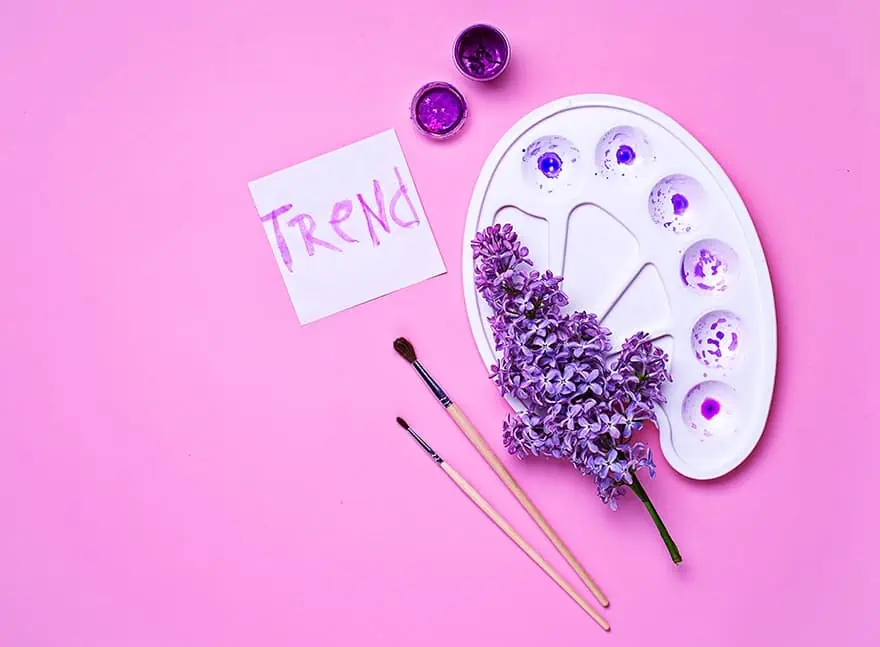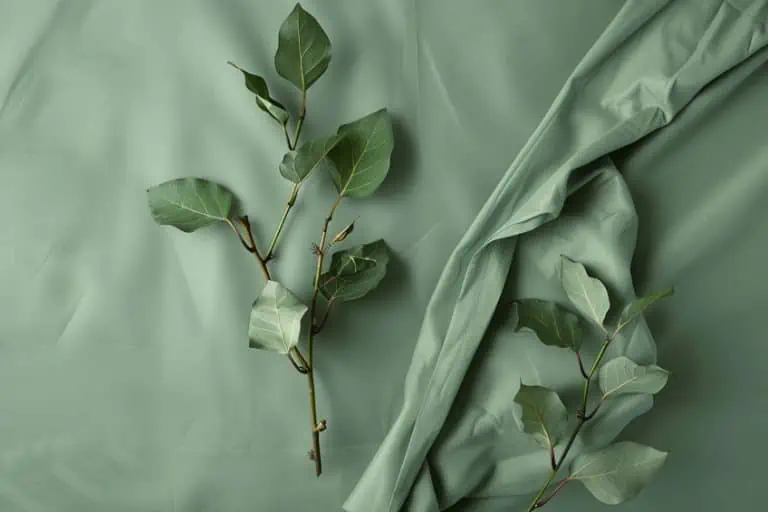Shades of Purple – Learn All About the Types of Purple
This post may contain affiliate links. We may earn a small commission from purchases made through them, at no additional cost to you.
The color purple is loved by many, as the color is linked to mystery and splendor and comes in a variety of amazing purple shades. In nature, many different types of purple flowers and berries are closely associated with the purple and violet color. Purple colors can range from bright purple to dark purple, and many more purple shades. So, with all these purple color choices, there is sure to be one that attracts your attention. Read further to discover some of the more popular purple names and how to incorporate shades of purple into your life.
Table of Contents
Shades of Purple: A Short History
Over the years, the purple color has had a major impact on society. Starting with grinding berries to obtain and use the natural pigment purple color contained within. Various shades of purple can be found throughout history. The first being Tyrian purple, also referred to as a royal purple. The dye was obtained from the mucus of a sea snail or mollusk that was found in the Mediterranean. The process involved was difficult and costly, which is why only the wealthy and nobility, such as Roman Emperors, could obtain and wear the dyed fabrics.
China created a synthetic color known as Han Purple during the 400 to 500 BC period. This color was used to decorate the terracotta army. The pigment was also used in the making of beads, on figurines and ceramic vessels, as well as on wall paintings. In the 17th century, a blue-purple named royal purple was the first recorded use of the purple color in English. Another synthetic purple color known as mauveine was discovered by William Henry Perkin in the mid-late 1850s. He was experimenting and trying to synthesize quinine. Instead, he discovered a synthetic organic dye, which was named mauveine or Perkin’s mauve, which became quite popular over the years. Even Queen Victoria was enamored with the color and wore a silk gown the color of mauve to a Royal Exhibition.
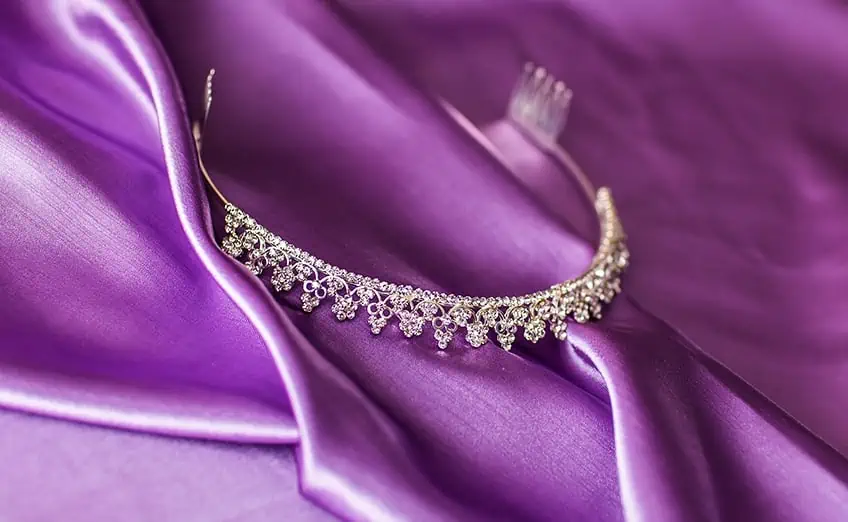
Other types of purple that have become known over the years include red-violet, which can be confusing to some as a purple color can have different meanings in different places. The violet color, to many, is more of a blue-dominated color between blue and red. However, in places like America, the red-violet color makes more sense. Many painters also see red-violet as more of an artist’s purple, especially if they follow the Munsell color system. A purple color that is equivalent to the red-violet pigment, is the electric purple that appears on your computer screen and is the purest purple color in this format. The computer creates a brighter purple than when you use actual pigments.
There are numerous other web computer purple colors and each of these have their own classification. Every color can be identified by its hex code. Below are the various colors mentioned above with their hex codes.
| Purple Names | Shades of Purple | Hex Code |
| Tyrian Purple | #66023C | |
| Han Purple | #5218FA | |
| Royal Purple | #7851A9 | |
| Mauveine | #8D029B | |
| Red-Violet Color | #C71585 | |
| Electric Purple | #BF00FF |
Purple Shades and Color Theory
Why is color theory significant when it comes to painting or other creative projects? Color theory is there to help provide guidelines, which can be used to create a variety of color schemes and visual effects. Colors are a great way to portray feelings and are vital in creating atmosphere, depth, and dimension in paintings. To help select colors, you have the color wheel, which has the primary, secondary, and tertiary colors and helps us understand what works and what will not work. The color wheel is a visual guide to help an artist, or anyone, to choose a color best suited for a particular project.
Creating Warmer and Cooler Shades of Purple
The basic idea of creating purple is combining the two primary colors red and blue. You can use whatever red or blue paint you have handy, however, the secondary purple color created might not be exactly what you are looking for. This is because most paints have a color bias, meaning they can lean towards another cooler or warmer color. For example, a popular color like phthalo blue is closer to green and has a cool bias. On the other hand, French ultramarine lies closer to red and has a warmer feel to it. Some have their own opinion on the matter, so it might be a good idea to mix your own colors and experiment with different ratios of reds and blues to get the purple color you want.

Making Purple Colors Lighter or Darker
To add dimension, depth, shadows, and highlight effects, you will need to make purple darker or lighter. A simple method for lightening a purple color is to add white. Adding white a little bit at a time should create a lighter purple without changing the hue. To lighten and create brighter purple, you can also try using yellow, however, yellow can also muddy your purple color if you add too much so you need to be careful. A lighter shade of yellow could work better, for example, cadmium lemon yellow will create a lighter purple version than cadmium yellow.
Purple can easily be made darker, which can help to create various depths of shadow in art pieces. In most cases, you will most probably need a selection of purple shades to create the effect you want. The first method of darkening purple involves adding black. However, most black paints tend to have a green base, which could cause some undesirable shades of purple. Too much black will also dull purple and it is difficult to go back as you cannot remove the black color. Try using alizarin crimson mixed with phthalo green to make an almost black color that can be used to darken your purple color.
To create a richer dark purple, consider using burnt umber as an alternative. However, the resultant shade will be a warmer purple. Another option is to use phthalo green, which should give you a stronger dark purple shade.
Complementary Purple Colors
We have mentioned the color wheel, and in this visual guide, you have your primary, secondary and tertiary colors. When observing the color wheel, you should note that each color has an opposing color, and is identified as its complementary color. When using these colors in paintings or even interior designing, they help each other to stand out or form a contrast. However, if you mix these two colors, they cancel each out and form a brown or black color. For example, yellow and purple are on opposing sides and are, therefore, complementary colors.
In marketing, for example in logo designs, you should be able to easily identify the use of colors that create a visible contrast. Take the Firefox logo, for example. The image is of a fox encircling the world, using blue and orange for contrast. This contrast idea also works effectively for interior design ideas. Some colors match purple, these colors are found close to each other when viewed on the color wheel. Since there is a variety of purple shades, you get your cool as well as warm undertones. So, if you choose the right type of purple, it can pretty much go with most colors.

The Difference Between Purple and Violet
Many use a violet color and purple interchangeably, but are they the same? No, these are different colors altogether. The main difference is that violet is visible in a single wavelength and is known as a spectral color, for example, it is one of the seven colors of a rainbow. Purple is different in that it is only visible as a blend of wavelengths. This means purple only becomes visible when the colors red and blue come together. When looking at the color wheel, you will notice violet, and purple is next to each other and are in-between blue and red. However, violet is nearer to blue, while purple sits a bit nearer to red.
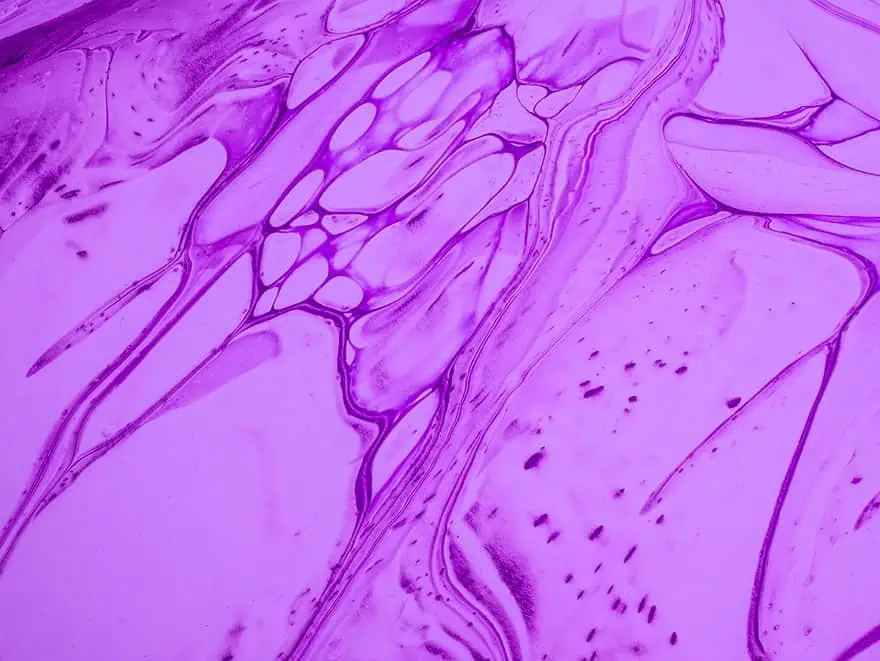
Popular Shades of Purple
There are a multitude of purple shades, each with a unique name. Each of these colors is also classified according to computer graphics and printing settings. The specific colors involved are represented in a hex code, which anybody can look up online. These colors also have the percentages of each, for example, red, green, and blue (RGB) for graphics and cyan, magenta, yellow and black (CMYK) for printing. Below are a few shades of purple names and their major uses, along with a small table with each colors’ information.
Amethyst
This is a dark moderate violet that represents the crystal which can have colors ranging from this deep purple to pale lilac. As with the amethyst crystal this color represents a certain calmness and tranquility.
| Purple Names | Shades of Purple | Hex Code | RGB % | CMYK % |
| Amethyst | #562f7e | 33.7, 18.4, 49.4 | 32, 63, 0, 51 |
Aubergine
The color represents the eggplant, or the aubergine, which has a skin that is a purple-brown color that has a fair amount of red included. The color was presented by Crayola in the late 1990s. The color is great as a fall color and works well in interior designs and fashion items. There is a warmth as well as a calming coolness that the color portrays.
| Purple Names | Shades of Purple | Hex Code | RGB % | CMYK % |
| Aubergine | #693b58 | 41.2, 23.1, 34.5 | 0, 44, 16, 59 |
Dark Purple
The dark purple almost looks black and can be used to darken blues and reds without adding black. Also, if you find that your yellows and oranges are a little too bright, you can add dark purple to mute the colors.
| Purple Names | Shades of Purple | Hex Code | RGB % | CMYK % |
| Dark Purple | #301934 | 18.8, 9.8, 20.4 | 8, 52, 0, 80 |
Bright Purple
This is a vibrant and bright purple color and when it comes to printing, there is double the amount of magenta when compared to the amount of cyan. Even though it is a bright color, it is darker than your neon purple, which can be a bit confusing.
| Purple Names | Shades of Purple | Hex Code | RGB % | CMYK % |
| Bright Purple | #bf40bf | 74.9, 25.1, 74.9 | 0, 66, 0, 25 |
Orchid
This is a vibrant color that can sometimes be seen in orchids found in nature. There are, of course, many shades of purple when it comes to purple and orchids including colors ranging from a deep red purple to a pink or gray-purple. The color name was first documented in 1915.
| Purple Names | Shades of Purple | Hex Code | RGB % | CMYK % |
| Orchid | #da70d6 | 85.5, 43.9, 83.9 | 0, 49, 2, 15 |
Lavender Field
When looking at a field of lavender in nature, you will understand why this color name was created. This color can be used in many color palettes to suit everything from wedding décor to interior design and nail art. Of course, the color is perfect for artists who wish to paint a lavender field landscape.
| Purple Names | Shades of Purple | Hex Code | RGB % | CMYK % |
| Lavender Field | #754C78 | 45.9, 29.8, 47.1 | 3, 37, 0, 53 |
Plum
The purple plum color can be seen as a reddish-purple, or it can have a gray-brown tint to it and represents the flesh of the plum fruit. The color name was first documented in 1805. The color is associated with a feeling of luxury and is uplifting and romantic. Plum is a deep, warm purple that can provide a sense of depth when painted onto walls.
| Purple Names | Shades of Purple | Hex Code | RGB % | CMYK % |
| Plum | #580f41 | 34.5, 5.9, 25.5 | 0, 83, 26, 65 |
Mulberry
Again, the color name is a representation of the mulberry fruit. This color became part of the Crayola family between 1958 and 2003 and was first documented in 1776. Prismacolor also created a pencil in the same color and was recognized as number 995.
| Purple Names | Shades of Purple | Hex Code | RGB % | CMYK % |
| Mulberry | #493c62 | 28.6, 23.5, 38.4 | 26, 39, 0, 62 |
Grape
Grapes do come in a range of colors; however, the purple grape color is a deep, amethyst purple that is slightly muted. The color works great as an accent wall in interior design, paired with a warm gray to create an amazing home décor look.
| Purple Names | Shades of Purple | Hex Code | RGB % | CMYK % |
| Grape | #5d1451 | 36.5, 7.8, 31.8 | 0, 78, 13, 64 |
Pure Purple
The pure purple color can be described as a dark magenta and forms part of the violet color family. The name has even been used for hair dye and has inspired perfume by Hugo Boss. In many cases, the pure purple color can be matched to produce wall paint, spray paints, and artist acrylic paints.
| Purple Names | Shades of Purple | Hex Code | RGB % | CMYK % |
| Pure Purple | #751973 | 45.9, 9.8, 45.1 | 0, 79, 2, 54 |
Mixing Shades of Purple Paint
Sometimes, you want a specific purple shade for your painting and the paint colors that come in a tube just do not get close to the color you are looking for. However, if you are looking for a good choice, then dioxazine purple is a good color to keep around. There are other purposes for the color purple. For example, the color purple can help to darken your blue and red colors and can help to mute your orange and yellow colors. However, when you mix your blue and red paints, you might be surprised by the color you get. We have a separate blog post about what colors make purple.
Creating Shades of Purple With Acrylics
Why do you get different colors when you blend red and blue? If you have the perfect primary blue and mix this with an equally perfect red, you should get a perfect purple. However, when it comes to paints, most contain a hint of other colors within, which creates a color bias. For example, you can get blue paints that have hints of red or yellow and red paints that contain hints of blue or yellow.
When considering color theory, we know that if you blend all three primary colors, you create a muddy brown color. So, if you take blue paint and blend it with a red that contains a hint of yellow, all three primary colors are present. This means the color that you create will not be a nice purple, but rather a muddy brown purple. When you purchase your paint, you will need to make sure the blue and red paints do not contain a color bias towards yellow or green, if you want to create a nice purple color. Remember, blue and yellow make green.
You can test your blue paint to check if it has a yellow bias by mixing in some white paint. If the paint simply comes out a lighter shade of blue, then there is no color bias. However, if it becomes a turquoise blue or you will notice it turning a greenish-blue, then you know the blue has a yellow bias.

When mixing acrylic paints, the best option for a vibrant purple is to combine a cool red and warm blue. For example, alizarin crimson or permanent rose are cool reds, with ultramarine blue, which is a warm blue. Another example is quinacridone magenta, which is your cool red, mixed with ultramarine blue. You can use equal amounts of these paints to create a vibrant purple. There are so many shades of purple, it is best to experiment with the colors you have to see what you can create. Each paint brand has its own formula, so depending on your choice of paints, you will get varying results in color. This is why it is a good idea to understand and check the product labels on the paints you are going to purchase.
Mixing Purple Watercolors
The same principles of color theory apply to watercolors when it comes to creating purple shades. However, there might be a few differences in the way you use them since watercolors are transparent and contain a color pigment within a water-soluble binder. Sometimes, when blending colors, they seem to separate, especially colors that are opposite in temperature values. Again, it is a good idea to look at the products’ labels as some may have more than one pigment, which can cause this separation. If you want hassle-free blending, look for paints that contain only a single pigment.
Some watercolor pigments will stain the paper faster than others, and these will settle more than the color it is blended with. Applying paints to a smoother surface and using less water can help prevent this. Thicker paints also tend to not mix as well as others.

When making pastel purple shades, the easiest method is to simply add more water until you reach the desired color. You can achieve this by using a watercolor palette that is fairly deep. You can also use white paint to lighten a purple color, but it should be added in small amounts as too much can create a more opaque paint color. To create a beautiful lavender watercolor, you can try adding a little white paint to some ultramarine blue paint. Lilac can be created by again using a cool red like quinacridone rose combined with ultramarine blue, which is then diluted with a little water. Below are a few more red and blue colors that work well together. Remember, a warm blue will work best with a cool red. These are also good for acrylic paints.
Warm Blue Colors
- Ultramarine blue
- Indigo
- Cyanine blue
- Brilliant blue
- Victorian blue
- Mountain blue
- Cobalt blue
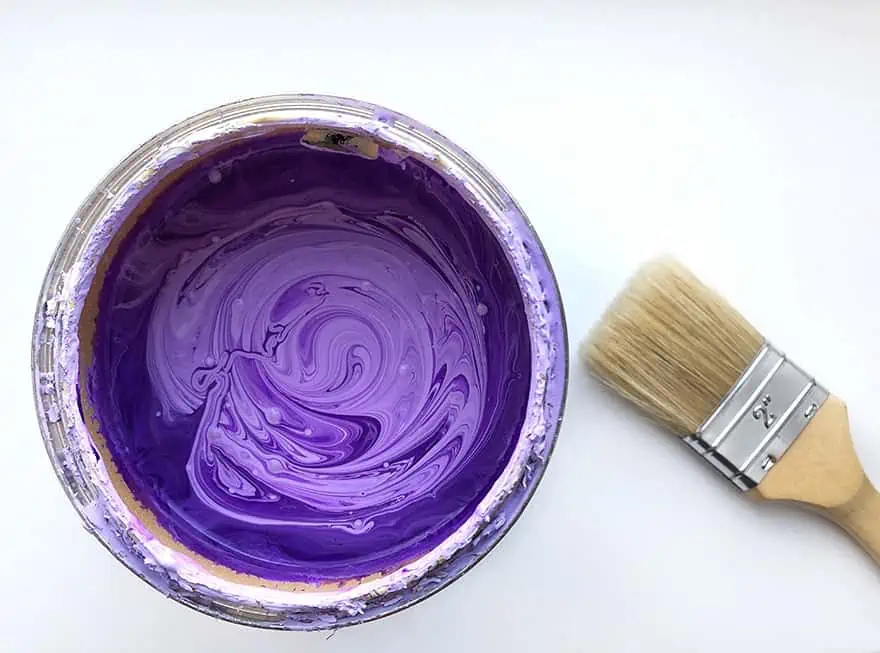
Cooler Reds
- Alizarin crimson
- Quinacridone magenta
- Carmine red
- Opera red
- Crimson lake red
- Rhodamine red
- Scarlet lake red
You can also easily purchase a variety of purple tube shades, which should do the job just fine. The quinacridone violet is a popular choice. However, if you want a specific purple shade, learning how to blend the various colors can provide more freedom in creating different colors. When purchasing watercolor paints, it is best to choose high-quality paints that contain single pigments and have good lightfastness. When looking at labels, the purple pigments are shown as pigment violet (PV) followed by a number, another example is pigment red (PR). So, ultimately, it is good to know your paints, what is in them, and your basic color theory so you can produce the best colors.
Shades of Purple in Décor
For some, purple may not be their first choice when it comes to painting their walls or using it at home, besides in a little girls’ room. However, there are many shades of purple, from lilac to lavender or aubergine. Some purple colors can be warmer, while others are cooler. So, purple can actually work with almost any color. Colors can be painted on the walls, furniture, or added as accessories. Complimentary colors work well together and provide a great contrast. Think of pairing a citron yellow, which is a darker yellow with a selected purple. Another option is lavender with a lemon yellow for a pop of color and cheeriness. As with all colors, there are many different shades and tones, so experiment with colors to find the one that you enjoy. For example, add a little more imagination and creativity to the mix with warm gold and purple.

Maybe you like a pop of purple color, but it can be a bit overwhelming, so you want to tone it down a bit. Consider adding cream or white accents to the room to bring things together. There are many types of purple and you do not have to stick to a bold or bright purple color. Consider more subtle tones like lilac paired with white.
Colors that are near to one another on the color wheel can also produce some wonderful effects. So, think navy and purple, and to bring everything together, add some bright greens to the mix. You can also consider a monochromatic look, by pairing darker and lighter shades of purple. To create a break in these colors, try adding soft gray colors and white. Shades of purple are not only amazing for interior design projects but can also successfully be used as a wedding color palette. Purple is a versatile color with many shades from dark purple to bright purple and everything in-between. Purple creates an elegant and romantic setting, perfect for wedding settings. Below are some ideas for purple color combinations:
- Amethyst and Lavender colors
- Light mauve or lilac with neutral colors
- Combination of vibrant purples with white
- Deep purple combined with dark and lighter grays
Tips for Creating Shades of Purple
Creating the perfect purple color can involve a lot of practice and experimentation to get just the right color you want. However, creating the perfect purple color also requires a knowledge of color theory and an understanding of what a specific product is made of. Have a look at these easy tips for producing the best purple color.
- Gain an understanding of pigment colors, as the color name is not an indication of what is inside your paint product
- The purple shade you create depends on the blue and red colors you use
- To create a vibrant purple, combine a warm blue and a cooler red
- Adding yellow to purple will help to tone your purple color down
- To create a vibrant purple, make sure you use paints with a single pigment. The pigments are usually displayed on the product label
- Complimentary colors help to make purple stand out
- When it comes to watercolors, acrylics, and oil paints, you might find the names can vary

Take a look at our shade purple webstory here!
Frequently Asked Questions
How Is a Bright Purple Color Achieved?
To create a bright purple, you should use a warm blue and mix it with a cool red. This will produce a vibrant purple. Remember, if you use a color that contains yellow, you might find that the color produced will be muddy and muted.
Is Violet The Same As Purple?
Even though some may consider violet and purple the same, they are not similar at all. Violet does sit between red and blue and is located next to purple. Violet is near to blue, while purple is near to red. Violet is also a spectral color, meaning it is visible in a single wavelength, while purple is a combination wavelength.

What Colors Create The Best Contrast With Purple?
When you are looking to create a pop of color or a significant contrast, using a complementary color is the way to go. These colors are located on opposing sides of the color wheel. The color purple sits opposite your oranges, yellows, and greens.
Does Blue And Red Create Purple?
Technically, yes red and blue make purple. However, when using paints, most have a color bias, and using a variety of reds and blues will create different purple colors.
Duncan graduated with a diploma in Film and TV production from CityVarsity in 2018, after which he continued pursuing film while taking on a keen interest in writing along the way. Since having graduated, he began working as a freelance videographer, filming a variety of music videos, fashion and short films, adverts, weddings and more. Throughout this, he’s won a number of awards from various film festivals that are both locally and internationally recognized. However, Duncan still enjoys writing articles in between his filming ventures, appreciating the peace and clarity that comes with it.
His articles focus primarily around helping up-and-coming artists explore the basics of certain colors, how these colors can be paired with other shades, as well as what colors are created when you mix one with another. All while relating these shades to historically significant paintings that have incorporated them into their color palette. As a lover of the arts himself, he takes great interest in the Renaissance era of paintings, an era that has directly inspired many of his favorite films.
Learn more about Duncan van der Merwe and about us.
